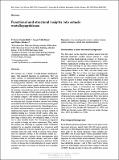Por favor, use este identificador para citar o enlazar a este item:
http://hdl.handle.net/10261/87872COMPARTIR / EXPORTAR:
 SHARE SHARE
 CORE
BASE CORE
BASE
|
|
| Visualizar otros formatos: MARC | Dublin Core | RDF | ORE | MODS | METS | DIDL | DATACITE | |

| Título: | Functional and structural insights into astacin metallopeptidases |
Autor: | Gomis-Rüth, F. Xavier CSIC ORCID ; Trillo-Muyo, Sergio CSIC; Stöcker, Walter | Palabras clave: | Tolloid Metzincin Meprin Catalytic domains Bone morphogenetic proteins |
Fecha de publicación: | 2012 | Editor: | Walter de Gruyter | Citación: | Biological Chemistry 393(10): 1027-1041 (2012) | Resumen: | The astacins are a family of multi-domain metallopeptidases with manifold functions in metabolism. They are either secreted or membrane-anchored and are regulated by being synthesized as inactive zymogens and also by colocalizing protein inhibitors. The distinct family members consist of N-terminal signal peptides and pro-segments, zincdependent catalytic domains, further downstream extracellular domains, transmembrane anchors, and cytosolic domains. The catalytic domains of four astacins and the zymogen of one of these have been structurally characterized and shown to comprise compact ~200-residue zinc-dependent moieties divided into an N-terminal and a C-terminal sub-domain by an active-site cleft. Astacins include an extended zinc-binding motif (HEXXHXXGXXH) which includes three metal ligands and groups them into the metzincin clan of metallopeptidases. In mature, unbound astacins, a conserved tyrosine acts as an additional zinc ligand, which is swung out upon substrate or inhibitor binding in a 'tyrosine switch' motion. Other characteristic structural elements of astacin catalytic domains are three large α-helices and a five-stranded β-sheet, as well as two or three disulfi de bonds. The N-terminal pro-segments are variable in length and rather unstructured. They inhibit the catalytic zinc following an 'aspartate-switch' mechanism mediated by an aspartate embedded in a conserved motif (FXGD). Removal of the pro-segment uncovers a deep and extended active-site cleft, which in general shows preference for aspartate residues in the specifi city pocket (S 1′). Furthermore, astacins undergo major rearrangement upon activation within an 'activation domain,' and show a slight hinge movement when binding substrates or inhibitors. In this review, we discuss the overall architecture of astacin catalytic domains and their involvement in function and zymogenic activation. Copyright © 2011-2012 by Walter de Gruyter. | Versión del editor: | http://dx.doi.org/10.1515/hsz-2012-0149 | URI: | http://hdl.handle.net/10261/87872 | DOI: | 10.1515/hsz-2012-0149 | E-ISSN: | 1437-4315 | Identificadores: | doi: 10.1515/hsz-2012-0149 issn: 1431-6730 |
| Aparece en las colecciones: | (IBMB) Artículos |
Ficheros en este ítem:
| Fichero | Descripción | Tamaño | Formato | |
|---|---|---|---|---|
| Functional and structural.pdf | 2,22 MB | Adobe PDF |  Visualizar/Abrir |
CORE Recommender
SCOPUSTM
Citations
70
checked on 11-abr-2024
WEB OF SCIENCETM
Citations
66
checked on 24-feb-2024
Page view(s)
540
checked on 18-abr-2024
Download(s)
978
checked on 18-abr-2024
Google ScholarTM
Check
Altmetric
Altmetric
NOTA: Los ítems de Digital.CSIC están protegidos por copyright, con todos los derechos reservados, a menos que se indique lo contrario.
